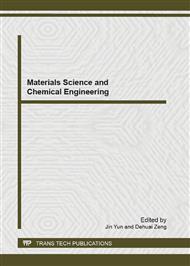[1]
W.S. Adaska, Controlled Low-Strength Materials. A Report from ACI Committee 229, Concrete International, Vol. 19 (1997), pp.41-43.
Google Scholar
[2]
L.K. Crouch, R. Gamble, J.F. Brogdon, and C.J. Tucker, Use of High-fines Limestone Screenings as Aggregate for Controlled Low-Strength Material (CLSM), ASTM STP 1331 (1998), pp.45-59.
DOI: 10.1520/stp13061s
Google Scholar
[3]
W.R. Bruce, Progress in CLSM: Continuing Innovation, Concrete International, Vol. 19(1998), pp.32-33.
Google Scholar
[4]
K. Amnon, and K. Konstantin, Utilization of industrial by-products for the production of controlled low strength materials (CLSM), Waste Management, Vol. 24 (2004), pp.501-512.
DOI: 10.1016/s0956-053x(03)00134-x
Google Scholar
[5]
R.A. Taha, A.S. Alnuaimi, K.S. Al-Jabri and A.S. Al-Harthy, Evaluation of controlled low strength materials containing industrial by-products", Building and Environment, Vol. 42 (2007), pp.3366-3372.
DOI: 10.1016/j.buildenv.2006.07.028
Google Scholar
[6]
M. Lachemi, K.M.A. Hossain, M. Shehata and W. Thaha, Controlled low strength materials incorporating cement kiln dust from various sources, Cement and Concrete Composites, Vol. 30 (2008), pp.381-392.
DOI: 10.1016/j.cemconcomp.2007.12.002
Google Scholar
[7]
S. Rafat, Utilization of waste materials and by-products in producing controlled low-strength materials, Resources, Conservation and Recycling, Vol. 54 (2009), pp.1-8.
DOI: 10.1016/j.resconrec.2009.06.001
Google Scholar
[8]
O. Ginés, J.M. Chimenos, A. Vizcarro, J. Formosa and J.R. Rosell, Combined use of MSWI bottom ash and fly ash as aggregate in concrete formulation: Environmental and mechanical considerations, Journal of Hazardous Materials, Vol. 169 (2009), pp.643-650.
DOI: 10.1016/j.jhazmat.2009.03.141
Google Scholar
[9]
A.R. Hashim, N. Sivakumar and N.A.H. Siti, Performance appraisal of industrial waste incineration bottom ash as controlled low-strength material, Journal of Hazardous Materials, Vol. 172 (2009), pp.862-867.
DOI: 10.1016/j.jhazmat.2009.07.070
Google Scholar
[10]
M.C. Nataraja and Y. Nalanda, Performance of industrial by-products in controlled low-strength materials (CLSM), Waste Management, Vol. 28 (2008), pp.1168-1181.
DOI: 10.1016/j.wasman.2007.03.030
Google Scholar
[11]
G. Yucel, D.S. Yasin, Y. Muhsin, T. Ahmet and D. Senayi, Re-usage of waste foundry sand in high-strength concrete", Waste Management, Vol. 30 (2010), pp.1705-1713.
DOI: 10.1016/j.wasman.2010.02.018
Google Scholar
[12]
Industrial Development Bureau, Ministry of Economic Affairs, Taiwan, (2002), Handbook on Recycling and Application of Printed Circuit Board, Taipei City, Taiwan.
Google Scholar
[13]
Public Works Department of Taipei City Government, Material Standard of Controlled Low-Strength Materials, Taipei City, Taiwan. (2001)
Google Scholar
[14]
J.L. Flechsig, Downtown Seattle Transit Project, International Symposium on Unique Underground Structures, Denver, CO. (1990)
Google Scholar
[15]
J.F. Young, A review of pore structure of cement paste and concrete and its influence on permeability, Permeability concrete, ACI SP 108-1 (1988), pp.1-18.
DOI: 10.14359/2136
Google Scholar
[16]
A.M. Neville, Properties of concrete, John Wiley and Sons, New York, USA. (1995), pp.490-495.
Google Scholar
[17]
S. Rafat and N. Albert, Utilization of spent foundry sand in controlled low-strength materials and concrete, Resources, Conservation and Recycling, Vol. 53 (2008), pp.27-35.
DOI: 10.1016/j.resconrec.2008.09.007
Google Scholar


